Geneva is extremely fortunate in having one of the world's finest museums of primitive art, the Barbier-Mueller Museum. Its proximity guided Vacheron Constantin to imagine The Métiers d'Art “Les Masques” collection.
But one obstacle remained: to win over the museum. Would it be willing to lend its treasures for months on end so that they could be reproduced on the dial of a collector's watch? In the end, two things convinced Jean Paul Barbier-Mueller of the project's beauty and significance: a lunch during which he and the Vacheron Constantin team headed by Juan-Carlos Torres were able to share their common passion for beautiful objects, and the manufacture's philosophy.
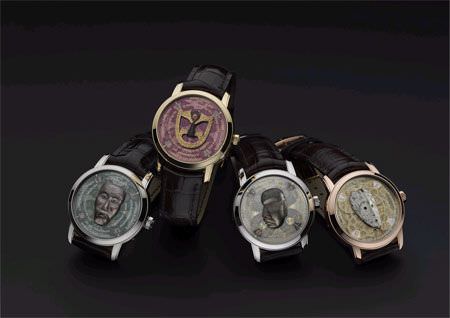
The rest was a matter of horological magic and the commitment of a team to surpass the limits of possibility. Twelve masks were selected from the Barbier-Mueller collection for small-scale reproduction in gold. They repose majestically at the centre of each timepiece in a collection that spans two thousand years and four continents.
Because Vacheron Constantin understands the value of time, it respected the time needed to create such exceptional pieces. Long months were required first of all to perfect the movement, and then the techniques with which the master craftsmen could reproduce these works of art in miniature. There had to be plenty of time for questioning, reflection and invention.
A collection cannot be hurried. That is why the Métiers d'Art “Les Masques” collection is a story that has unfurled over time. Every year for three years - 2007 to 2009 - a boxed set of four different masks has been presented in a limited series of 25.
A complete set of the twelve timepieces reproducing the twelve masks - from the limited edition of 300 exceptional timepieces - is currently on display at the Metropolitan Museum of Art in New York at an exhibition sponsored by Vacheron Constantin and called “A Legacy of Collecting: African and Oceanic Art from the Barbier-Mueller Museum, Geneva” in tribute to Jean Paul Barbier-Mueller.
A work of Art in miniature
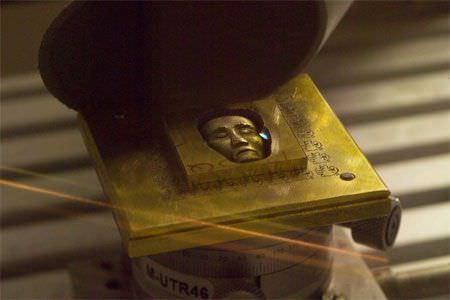
Each timepiece is equipped with the automatic Calibre 2460G4 movement, made by the manufacture and bearing the prestigious Poinçon de Genève. Thanks to this very special movement, the time can be read without any hands: by means of a set of wheels and gears, four discs indicate the hours, minutes, day and date in windows, leaving the centre of the dial empty for the masks to be placed there and for the craftsmen to give free rein to their creativity.
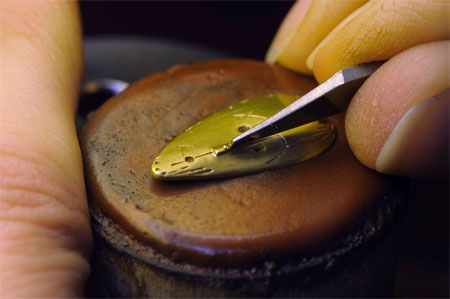
The movement was completely redesigned to receive the masks; even though time is the raison d'être here, the masks are the focus of attention and had to be put in the spotlight. To ensure that they were, the team of designers decided to virtually conceal the movement. A clever technique using transparency and specially-treated glass creates the impression that the masks are floating. Each sapphire crystal has a different tint, obtained by a unique metallisation process, so that it sets off the colour of the mask. The effect is breathtaking: the miniature sculpture seems within reach, a silent guardian of ancestral secrets.
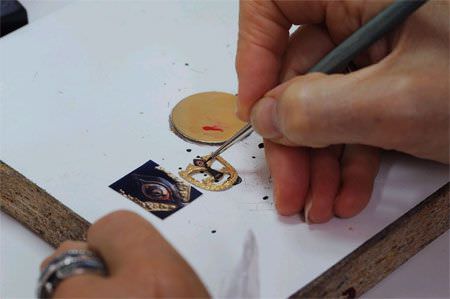
Finally, it required all Michel Butor's talent to give voice, if not life, to the masks. His magnificent words, short poems in prose dedicated to each mask, circle the sapphire dial in letters of gold. The writer's lines follow each other in a spiral that seems to have no beginning and no end, a mysterious message that can only be read when the light strikes it from a certain angle. This effect is achieved by vacuum metallisation, a sophisticated technological process in which the gold letters are sprayed onto a sapphire crystal. Thanks to the multiple play of light and transparency, the watch has secrets that it will only ever share with its owner.
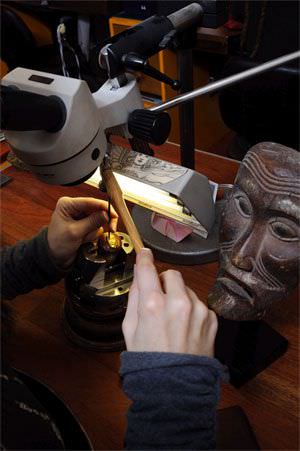
2009: PRESENTATION OF THE THIRD AND FINAL SET
OCEANIA – INDONESIA
Facial Mask
Island of Lombok, Sasak people
Hard wood, traces of white pigments
Height: 21.5 cm
Former collection of Mathias Komor
Inv. 3320-A
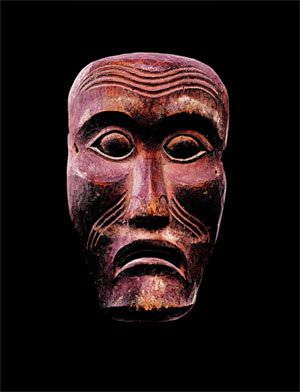
I dance the duration the wait
patience the resistance
to suffering and to evil
the slowness of the days and nights
stammerings recognition
resignation but vigilance
the hasty passage of the months
and the devouring of the months
Michel Butor
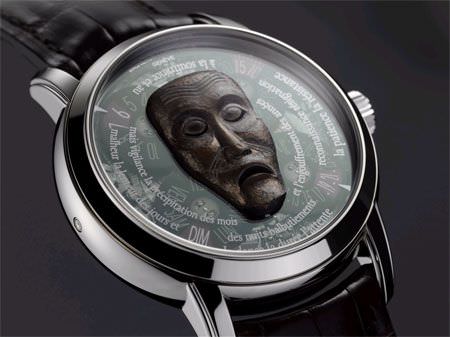
With its air of bewilderment, this mask has both realistic and geometrical features and is dominated by the large eyes. It clearly represents an old man with its sunken cheeks, dark rings under the eyebrows, and especially the wrinkles that furrow its brow and the folds between the nose and mouth. These wrinkles animate the face and help give dramatic expression to the character, which seems to raise its eyebrows and half-open its mouth in amazement. The old man was a regular character in Balinese Wayang Topeng theatre. The masked actors did not speak because they had to hold their masks between their teeth with a leather thong. It was therefore left to the narrators and singers to describe the intrigue and recount the heroes' adventures.
ASIA - CHINA
Zangs-Bag facial Mask
Tibet region, Tantric Buddhism. 16th-17th century
Partially-gilt copper, pigments
Height: 22.2 cm
Inv. 2504-168
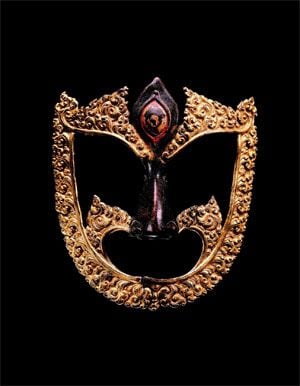
With my ornaments I surround
the emptiness opening in your eyes
and in your mouth a third
eye appearing on the forehead
to guide you in your labours
in the labyrinth of your lives
and those of your children
who continue your adventures
Michel Butor
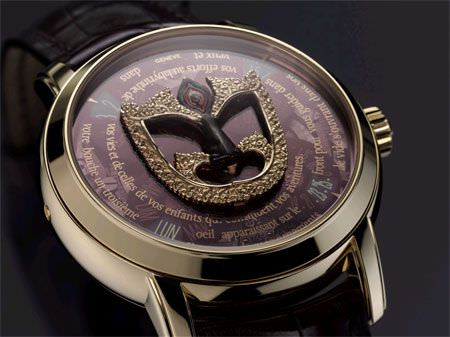
A mystery, even a profound sacredness, seems to emanate from this half-empty mask. And yet the highly naturalistic nose reminds us that this figure with its frozen expression has a human side. The divine is expressed by the strange mandorla, positioned like a jewel on the forehead of the mask and enclosing a painted eye. A beautifully designed frieze of gold-covered arabesques and scrolls frames the empty spaces. This type of zangs-’bag mask was worn by certain monks from the dGe-lugs-pa yellow hat sect. The masks were used in dances linked to the cult of Kâlacakra (the Wheel of Time).
AMERICAS – MEXICO
Pendant Mask
State of Guerrero
Mezcala culture (300 – 100 BC)
Basalt
Height: 12.8 cm
Inv. 505-26
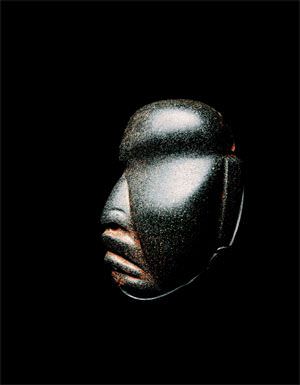
At regular intervals
during the dance I come and strike
the heart whose pulse
races at the screams
reverberating off the walls
that protect us from the ghosts
of felines and enemies
who venture onto our land
Michel Butor
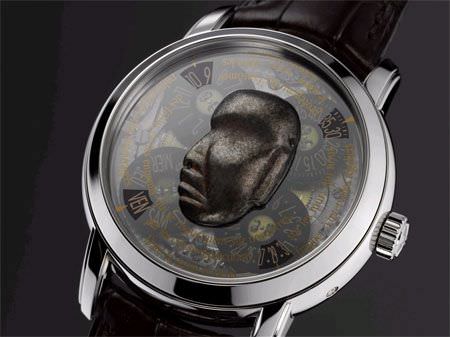
Blending the influences of several cultures in a singular style, this pendant mask conveys all the artist's virtuosity. Its powerful and austere profile comprises both abstract and naturalistic features. The upper part of the face and the diagonal of the cheek are treated in a minimalist fashion; by contrast, the aquiline nose and down-turned mouth seem far more realistic. This mask belongs to the Mezcala culture. During the classical period, it was the custom of these people to bury their dead under the mud floors of their dwellings. In accordance with a ritual related to the ancestral worship of the dead, the tombs were full of small hard-stone sculptures of asexual human figures, heads, plaques decorated with faces, masks, and animal effigies.
AFRICA – GABON
Ngontang Mask
Western Gabon, Fang people
Soft wood covered with white kaolin, specks of crystallisation
Height: 31 cm
Inv. 1019-76
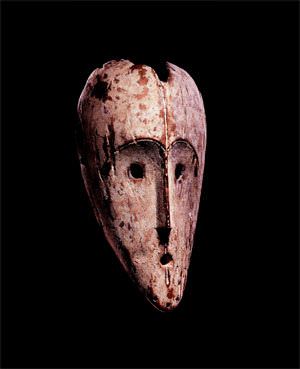
The line of my nose extending
between the eyebrows on my forehead
and on the other side to
my chin across my mouth
is like an arrow fi red
by a bow towards the celestial heights
beyond the clouds
or naturally the bird
into which your soul changes
Michel Butor
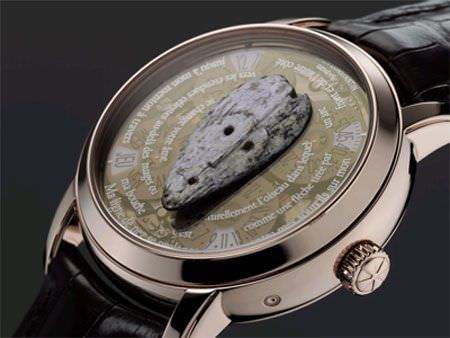
The sobriety of this white mask, with its melancholic air and o-shaped mouth, shows the sculptor's remarkable sensitivity. It is covered with white kaolin, a colour that for the Fang, as for many other African tribes, referred to the spirit of the dead. The expressive power of the face is produced by the vertical line suggesting the nose as well as the scarifications from the chin to the forehead and from which two welldefined, curved eyebrows branch out. This mask was used in a ritual dance linked to the Byeri's cult of ancestor worship. Although its use did not have any particularly religious significance, the initiated dancer had to respect certain ritual gestures and taboos. These dances were intended to protect the village from witchcraft and evil influences.
Source: Vacheron Constantin
www.vacheron-constantin.com




